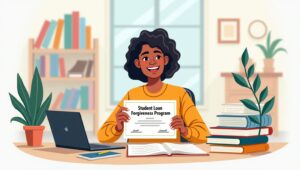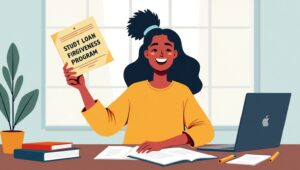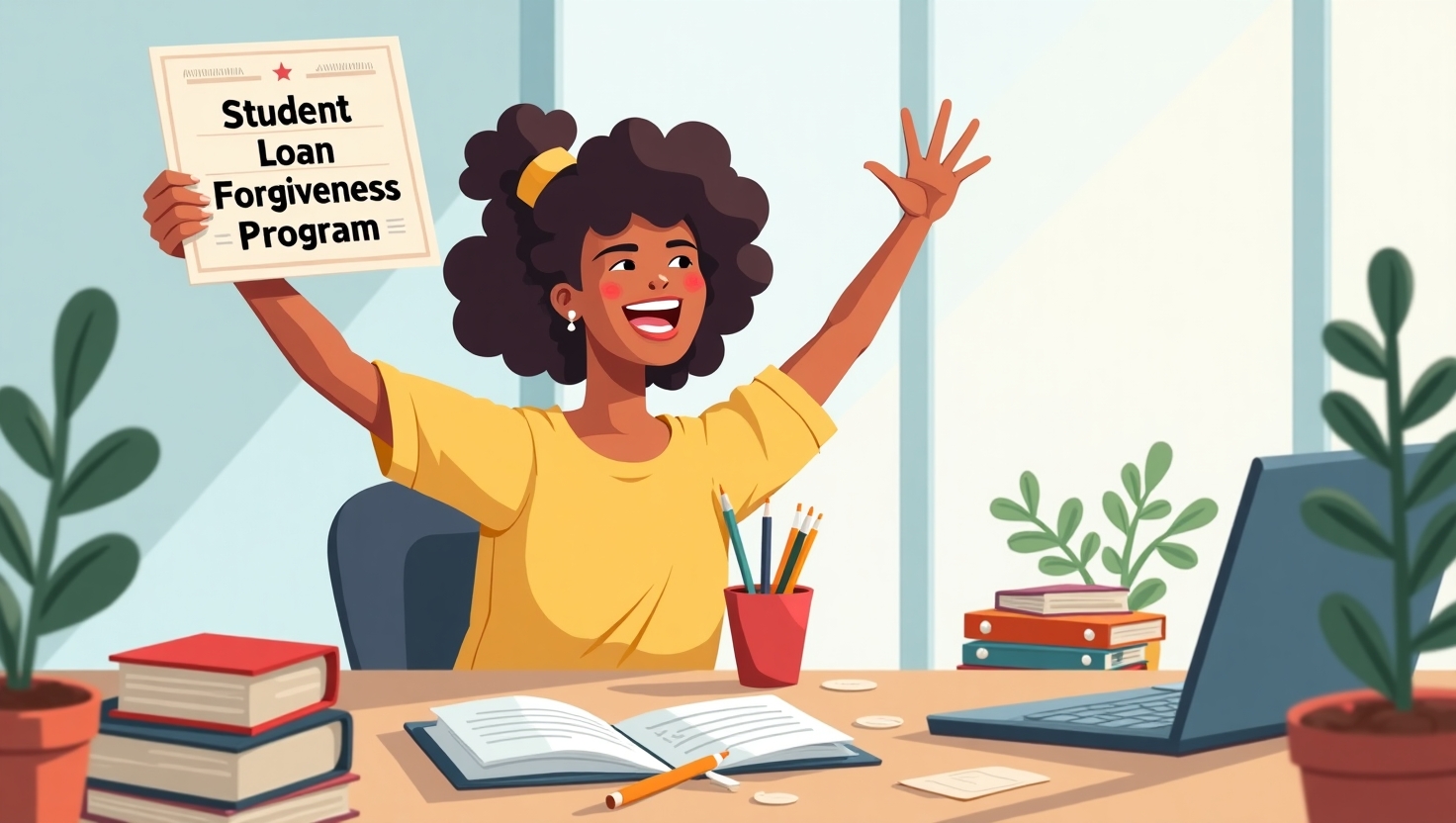Student Loan Forgiveness Program: What You Need to Know in 2025
Student loan debt is a heavy burden for millions of Americans. With the average borrower owing tens of thousands of dollars, it’s no surprise that many are searching for relief. The Student Loan Forgiveness Program offers hope to eligible borrowers by reducing or eliminating federal student loan debt. But navigating these programs can feel like learning a new language.
This comprehensive guide breaks down what student loan forgiveness is, who qualifies, how it works, and how you can apply—step by step. If you’re drowning in student debt, you’re not alone, and there may be a light at the end of the tunnel.

1. What is Student Loan Forgiveness?
Student loan forgiveness refers to government programs that cancel part or all of a borrower’s federal student loan balance, typically in exchange for meeting certain requirements like working in public service, teaching, or making consistent payments under an income-driven repayment plan.
Key programs include:
-
Public Service Loan Forgiveness (PSLF)
-
Teacher Loan Forgiveness
-
Income-Driven Repayment (IDR) Forgiveness
-
Perkins Loan Cancellation
-
Closed School Discharge
-
Total and Permanent Disability Discharge
Let’s take a closer look at each one.
2. Public Service Loan Forgiveness (PSLF)
This is one of the most well-known programs and can be life-changing for those who qualify.
Eligibility Criteria:
-
Work full-time for a qualifying government or non-profit employer
-
Make 120 qualifying monthly payments under a qualifying repayment plan
-
Have Direct Loans (or consolidate eligible loans into a Direct Consolidation Loan)
Important:
Only payments made after October 1, 2007 count, and you must still be working in public service when you apply.
Common Qualifying Jobs:
-
Teachers
-
Nurses
-
Firefighters
-
Social workers
-
Military members
-
Federal/state/local government employees
3. Teacher Loan Forgiveness
Teachers serving in low-income schools or high-need subject areas may qualify for up to $17,500 in forgiveness.
Eligibility Requirements:
-
Must teach full-time for five consecutive years
-
Work in a low-income school or educational service agency
-
Must hold a state certification or license
How Much Can You Get?
-
Up to $17,500 for math, science, and special education teachers
-
Up to $5,000 for other qualifying teachers
4. Income-Driven Repayment (IDR) Forgiveness
If you enroll in an IDR plan, your monthly payments are based on your income and family size. After 20 to 25 years of consistent payments, the remaining balance is forgiven.
Types of IDR Plans:
-
PAYE (Pay As You Earn)
-
REPAYE (Revised PAYE)
-
IBR (Income-Based Repayment)
-
ICR (Income-Contingent Repayment)
-
SAVE Plan (replacing REPAYE in 2024–2025)
Forgiveness Timeline:
-
20 years for undergraduate loans
-
25 years for graduate loans (varies by plan)
👉 Bonus: As of 2025, forgiven amounts under IDR plans are not considered taxable income, thanks to the American Rescue Plan (valid through 2025).
5. Perkins Loan Cancellation
Although Perkins Loans are no longer being issued, many borrowers still carry them. If you work in certain public service roles, you may be eligible for partial or full cancellation of your Perkins Loan.
Qualifying Jobs:
-
Teachers in shortage areas
-
Nurses and medical technicians
-
Law enforcement officers
-
Librarians in Title I schools
-
Early childhood education providers
Cancellation rates range from 15% to 100% over five years of eligible service.
6. Other Forgiveness & Discharge Options
a) Total and Permanent Disability Discharge (TPD)
If you’re totally and permanently disabled, your federal loans may be discharged after submitting proper medical documentation or a Social Security determination.
b) Closed School Discharge
If your school closes while you’re enrolled (or shortly after you withdraw), you may qualify for a 100% loan discharge.
c) Borrower Defense to Repayment
If your school misled you or engaged in fraudulent practices, you may be eligible for forgiveness.
7. The Biden Administration and Student Loan Forgiveness (2025 Update)
President Biden’s administration has made student loan relief a major focus. While broad loan cancellation has faced legal challenges, the government has:
-
Approved $140+ billion in targeted forgiveness (as of early 2025)
-
Expanded eligibility for PSLF via the Limited PSLF Waiver
-
Launched the SAVE Plan, offering lower monthly payments and faster forgiveness for low-income borrowers
-
Streamlined forgiveness for disabled borrowers and victims of school fraud
While widespread student loan cancellation is still uncertain, targeted relief has already helped millions of borrowers.

8. Step-by-Step Guide: How to Apply for Student Loan Forgiveness
✅ Step 1: Know What Loans You Have
Visit Studentaid.gov and log in with your FSA ID to view your federal loan types.
✅ Step 2: Choose the Right Program
Based on your job, loan type, and repayment history, determine which forgiveness program fits your situation.
✅ Step 3: Enroll in the Appropriate Repayment Plan
For PSLF or IDR forgiveness, you must be on a qualifying repayment plan—usually an IDR plan.
✅ Step 4: Submit Annual Certifications
For PSLF, submit the Employment Certification Form (ECF) each year to track progress.
✅ Step 5: Complete the Forgiveness Application
After meeting all criteria, submit the forgiveness application through Studentaid.gov.
9. Common Myths About Student Loan Forgiveness
❌ Myth 1: All student loans are forgiven after 10 years
Only if you meet strict PSLF requirements.
❌ Myth 2: Private loans qualify for forgiveness
Nope. Only federal loans are eligible for forgiveness programs.
❌ Myth 3: I have to pay taxes on forgiven loans
Generally false through 2025 for federal loans. Tax implications may change, so check the IRS website.
❌ Myth 4: Applying hurts your credit
Applying for forgiveness does not negatively impact your credit score.
10. Tips for Maximizing Your Chances of Forgiveness
-
✅ Keep all documentation of employment and payments
-
✅ Submit annual certifications religiously (for PSLF)
-
✅ Re-certify your income every year if on an IDR plan
-
✅ Sign up for autopay to avoid missed payments
-
✅ Use trusted government websites—never pay third parties
11. What About Private Student Loans?
Sadly, private student loans are not eligible for federal forgiveness programs. However, you can explore:
-
Refinancing to lower your interest rate
-
Hardship programs offered by some lenders
-
State-based forgiveness or repayment assistance programs
Conclusion: Is Student Loan Forgiveness Right for You?
The Student Loan Forgiveness Program is more accessible than ever before—but it’s not a one-size-fits-all solution. Understanding your options, staying compliant with requirements, and keeping documentation up-to-date are key to making the most of these programs.
Whether you’re a public servant, teacher, or simply someone with years of consistent payments, relief is possible. So don’t leave money on the table—start exploring your forgiveness options today.
Frequently Asked Questions (FAQs)
1. Can I qualify for more than one forgiveness program?
Yes, but not for the same loan. For example, you can’t use the same loan for both Teacher Loan Forgiveness and PSLF.
2. What if I’m not eligible for any forgiveness programs?
You can still explore income-driven repayment plans or refinancing options to lower your monthly burden.
3. Is student loan forgiveness taxable?
Through 2025, forgiven federal loan amounts are not considered taxable income, thanks to the American Rescue Plan.
4. Do Parent PLUS loans qualify?
Yes—but only under certain conditions, such as being repaid under an Income-Contingent Repayment plan and used for PSLF.
5. How long does it take for forgiveness to process?
It can take anywhere from a few weeks to several months. Make sure all documents are complete and accurate.

